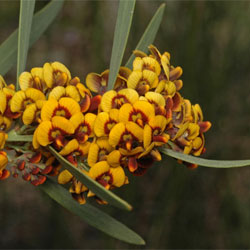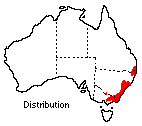Daviesia mimosoides
 |
 |
Narrow-leaf Bitter Pea, Leafy Bitter-pea
The large genus Daviesia, commonly known as Bitter Peas, has an Australia-wide distribution with about 110 species. Most occur in Western Australia where there are more than seventy species. They are included in the family Fabaceae, one of the three legume families, all of which have fruit known as a pod or legume. This large useful group of families has nitrogen-fixing bacteria in root nodules or small swellings on the roots, which benefit the soil wherever they flourish.
 Daviesia
mimosoides, or Narrow-leaf Bitter Pea, is a widespread variable shrub which
is found growing in a variety of habitats ranging in altitude from sea level
to 1500 m. The distribution of the species extends from Maroochydore in southern
coastal Queensland southwards through the coast and tablelands of New South
Wales and the Australian Capital Territory to the eastern highlands of Victoria.
It usually occurs in open forests dominated by a variety of eucalypts, although
in coastal and mountainous areas it occurs in heath. In the southern mountainous
regions of NSW and the ACT it often dominates much of the understorey.
Daviesia
mimosoides, or Narrow-leaf Bitter Pea, is a widespread variable shrub which
is found growing in a variety of habitats ranging in altitude from sea level
to 1500 m. The distribution of the species extends from Maroochydore in southern
coastal Queensland southwards through the coast and tablelands of New South
Wales and the Australian Capital Territory to the eastern highlands of Victoria.
It usually occurs in open forests dominated by a variety of eucalypts, although
in coastal and mountainous areas it occurs in heath. In the southern mountainous
regions of NSW and the ACT it often dominates much of the understorey.
Daviesia mimosoides is very attractive when in flower and has colourful red stems when young. It has a multi-stemmed open habit growing to a height of 1-2 m. The alternate lance-shaped leaves which are 50 - 100 mm long are thick and rigid, resembling the foliage of some acacias, hence the name 'mimosoides' (mimosa-like). The pea-shaped flowers, which are a familiar component of the Australian bushland, are yellow suffused with dark red or maroon and are borne in 5 to 10 flowered clusters. They appear as early as August on the coast, finishing as late as December at high altitudes. The fruit is a triangular-shaped flattened pod.
Daviesia mimosoides is hardy, quick-growing and green throughout the year. It is readily propagated from seed which should be scarified or treated with boiling water before sowing. Plants will grow in semishade but perform best in a well-drained sunny position which is well mulched. They respond to light pruning after flowering in the early stages of development. An application of a complete fertiliser in spring and autumn is beneficial.
A particularly attractive form of D. mimosoides occurs in the New England area of New South Wales. It has arching branches and denser flower clusters with brighter yellow flowers than the more common form.
Text by Effie Mullins, ANBG (1989)
Name meaning: Daviesia mimosoidesDaviesia - in honour of the Rev. Hugh Davies, Welsh botanist (1739 - 1821), mimosoides - like mimosa, a name applied to some species of Acacia (and thus 'Acacia-like'). |
![An Australian Government Initiative [logo]](/images/austgovt_brown_90px.gif)

